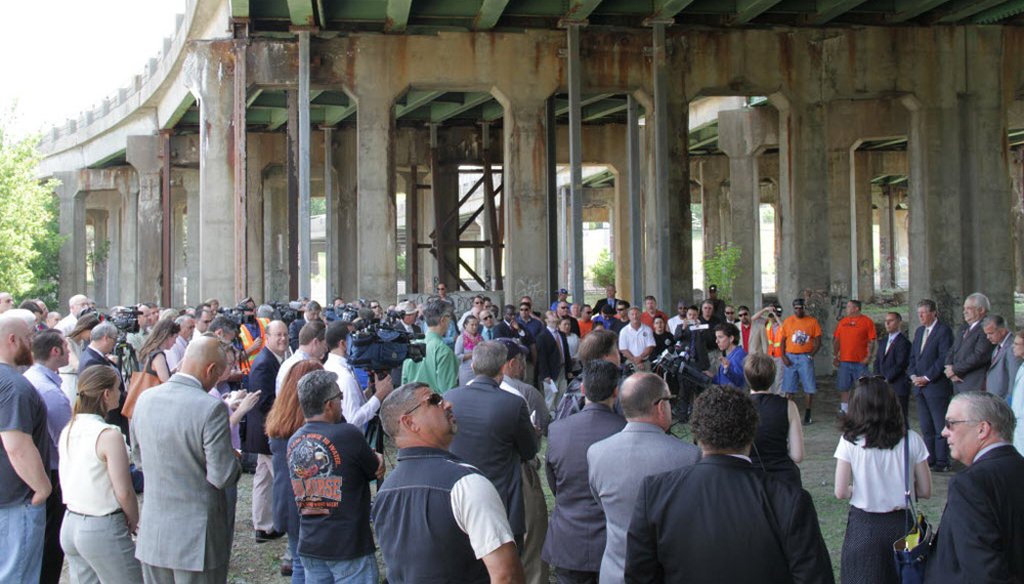



Gov. Raimondo calls for tolls on heavy trucks. She held her press conference below a rusted section of the 6-10 connector.
The state’s bridges and highways need repair and part of Governor Raimondo’s proposed solution is to make the owners of big trucks pay the tab for bridge projects.
On May 27, Raimondo announced that she hoped to raise $700 million for the "RhodeWorks" program by establishing tolls specifically for certain trucks. "Eighteen wheelers and above" was how she put it.
Why was Rhode Island’s governor so focused on those types of trucks?
"It’s commercial vehicles 18 wheelers and above and the fact of the matter is, those are the trucks that cause 90 plus percent of the damages on our highways and bridges. They're also the ones that benefit the most from high quality well-maintained roads," Raimondo said.
Senate President M. Teresa Paiva Weed echoed Raimondo’s statement, saying the toll proposal would focus the "burden of bridge maintenance squarely and fairly on the large commercial trucks."
That seemed like a lot of damage to pin on a small number of vehicles,18 wheelers and above.
PolitiFact went to Marie Aberger, the governor’s spokeswoman, for an explanation. It turns out the governor had misspoken during her news conference that day under the rusting connector for Route 6 and Route 10.
Soon after the governor made the statement, Aberger clarified it for reporters, telling them that the toll proposal wasn’t just for 18 wheelers and above. It was for large commercial trucks including 18 wheelers.
At the time, Aberger also distributed a PowerPoint presentation that identified trucks subject to the toll — and ostensibly responsible for the damage. That group of vehicles included all tractor trailers, including some with more than 18 wheels as well as some big trucks with three or more axles, such as certain types of dump trucks.
And what’s the evidence that this broader group of trucks causes 90 plus percent of damage to roads and bridges?
The answer is complicated, but for decades, engineers have agreed that heavy trucks cause far more damage than other lighter vehicles. The damage caused by a single heavy truck can be 9,600 times the damage caused by a single car, according to a U.S. General Accounting Office report cited by the governor’s office.
Finally, six separate damage calculations given to PolitiFact by the administration show, in all but one case, that the damage caused by heavy trucks appears to exceed 90 percent of all vehicle-related damage.
But what about ice and salt, snow and flooding? Or maintenance? Or the age of the highway?
The governor didn’t say anything about other important factors — including weather damage, leaving the impression that those 18-wheelers were almost entirely to blame.
On that point, Aberger said that the administration’s damage calculations were only for damage caused by vehicles. That, she said, was the governor’s focus when she said heavy trucks were responsible for "for 90 plus percent of the damages on our highways and bridges." A spokesman at the Department of Transportation had a similar explanation.
Interestingly, the GAO report that the administration cited prominently as a source for its calculations on vehicle-related road and bridge damage lists weather as one of four principal factors in the deterioration of roads and bridges.
"There are several reasons why highways deteriorate," says the report. "Principal among these are weather, deferred maintenance, highway age, and increased traffic."
Our ruling
Raimondo’s claim that "18 wheelers and above cause 90 plus percent of the damages to our highways and bridges" was quickly corrected by her spokeswoman. Fine.
But neither Raimondo nor the state’s PowerPoint discussed damage from weather — or from deferred maintenance for that matter — leaving the impression that those heavy trucks were the only problem.
For those reasons, we rate her statement, Half True.
(If you have a claim you’d like PolitiFact Rhode Island to check, email us at [email protected]. And follow us on Twitter: @politifactri.)
Video of Gina Raimondo press conference, Capitol TV, May 27.
Emails from Governor Raimondo’s spokeswoman, Marie Aberger, June 8, 9, 10 and 26, and interviews June 22 and 26, and July 9.
Testimony of Henry Eschwege, before a subcommittee of the U.S. House Committee on Ways and Means, regarding the 1979 U.S. General Accounting Office report entitled, "Excessive truck weight: an expensive burden we can no longer support."
U.S. General Accounting Office, "Excessive truck weight: an expensive burden we can no longer support," July, 1979.
U.S. Federal Highway Administration, "Addendum to the 1997 Federal Highway Cost Allocation Study Final Report," U.S. Department of Transportation, Federal Highway Administration, May 2000.
U.S. Federal Highway Administration, "Annual Vehicle Distance Traveled in Miles and Related Data, By Highway Category and Vehicle Type," accessed June 22.
Interview with Christopher Maxwell, president of the Rhode Island Trucking Association, June 23
Email from Norita Taylor, spokeswoman, Owner-Operator Independent Drivers Association, June 23.
Interview with Rhode Island Department of Transportation director Peter Alviti Jr., DOT’s deputy director, Peter Garino, and DOT’s supervising planner, Andy Koziol, July 9.
In a world of wild talk and fake news, help us stand up for the facts.
